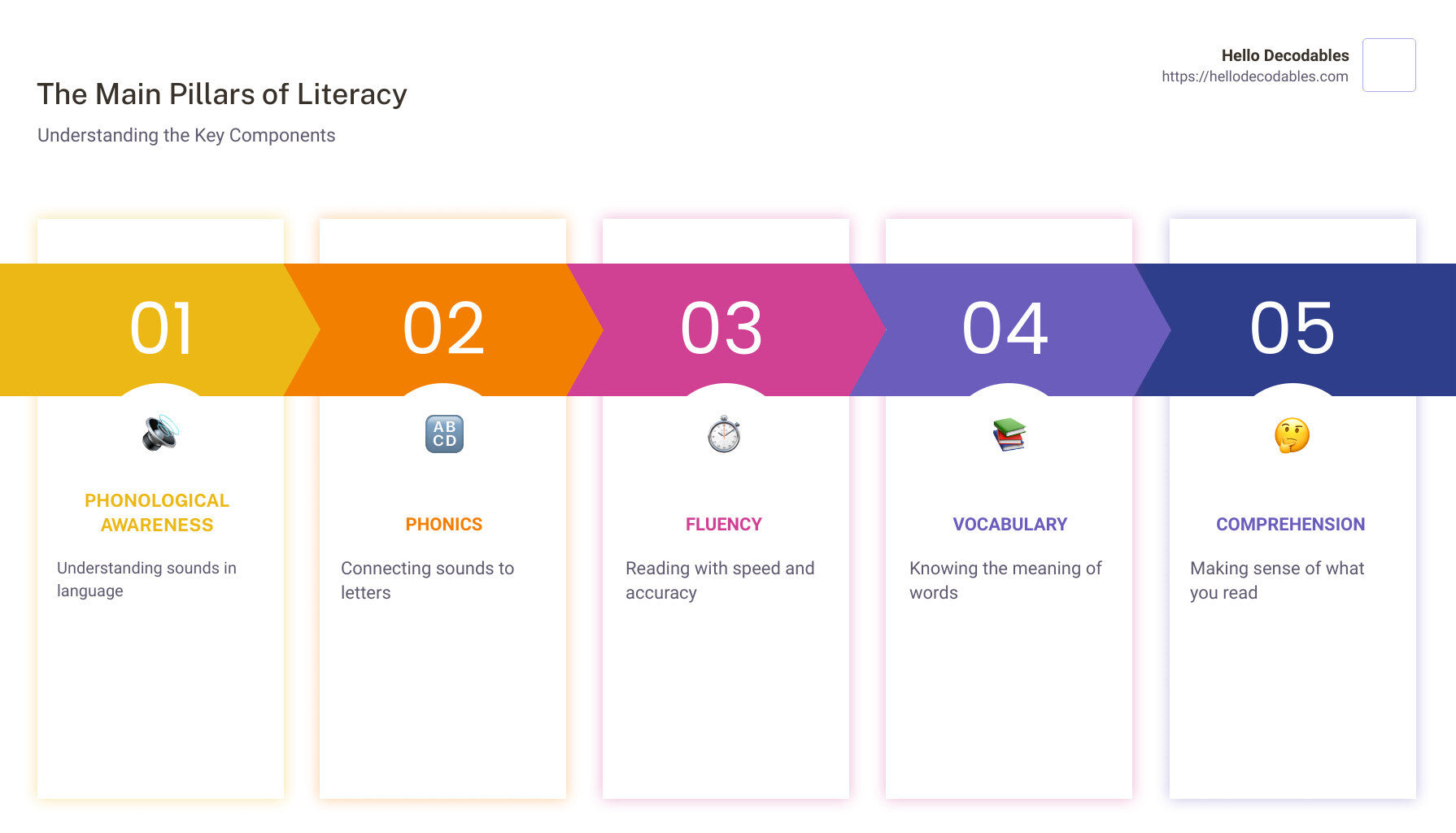
· By Jen Jones
From Sounds to Sentences: Understanding the Foundation of Literacy
Introduction
What is the foundation of literacy? At its core, literacy involves the ability to read, write, speak, and listen. It goes beyond just recognizing words on a page to include understanding, communicating, and interacting with the world. Here are the main pillars that form the foundation of literacy:
- Phonological Awareness: Understanding sounds in language
- Phonics: Connecting sounds to letters
- Fluency: Reading with speed and accuracy
- Vocabulary: Knowing the meaning of words
- Comprehension: Making sense of what you read
Literacy is crucial. It's the key to lifelong learning and opens doors to countless opportunities. As the World Literacy Foundation notes, people who can’t read or write struggle with everyday tasks like reading medicine labels or filling out job applications. By helping children develop literacy skills, we pave the way for them to break the cycle of poverty and succeed in life.
The importance of literacy can't be overstated. It unlocks cognitive development, fosters creativity, and forms the foundation for building lifelong learners. Early literacy development, especially in children aged 3 to 6, is pivotal in creating a strong base for future academic and personal success.
What is the Foundation of Literacy?
Understanding what is the foundation of literacy is crucial for fostering early reading skills in children. Let's break down the key components that form this foundation: phonological awareness, phonics, fluency, vocabulary, and comprehension.
Phonological Awareness
Phonological awareness is the ability to recognize and manipulate the sound structures of language. This includes skills like identifying rhyming words and counting syllables.
For example, when kids play with compound words like "sun" and "flower" to make "sunflower," they’re developing phonological awareness. This skill is a precursor to phonics and is essential for decoding words later on.
Phonics
Phonics involves understanding the relationship between letters and sounds. It’s about teaching kids that the letter "s" makes the /s/ sound and that combining letters like "c" and "a" forms the word "cat."
Using decodable texts, which focus on specific phonics skills, can be incredibly effective. For instance, a decodable book might focus on the long "a" sound spelled "ai" and "ay," helping kids practice and apply what they've learned.
Fluency
Fluency is the ability to read text accurately, quickly, and with proper expression. Think of it as reading smoothly, like talking. Fluent readers can focus more on understanding the text rather than decoding each word.
Imagine a child reading Dr. Seuss's Hop on Pop. They might start by sounding out each word slowly, but with practice, they read the rhyming words "cup-pup" and "house-mouse" with ease and expression, enhancing their overall reading experience.
Vocabulary
Vocabulary development is about knowing and using words. There are three types of vocabulary: receptive (words we understand), productive (words we use), and sight-word (words we recognize instantly).
For example, in Mo Willems’s Don’t Let the Pigeon Drive the Bus, the word "driver" might be new to some kids. Teaching this word can be useful in their everyday conversations, making it a valuable addition to their vocabulary.
Comprehension
Comprehension is the ultimate goal of reading. It’s about understanding and making meaning from the text. All the skills mentioned above—phonological awareness, phonics, fluency, and vocabulary—contribute to comprehension.
When a child reads a story and can discuss what happened, why it happened, and how it made them feel, they are demonstrating strong comprehension skills. This ability to understand and engage with text is what makes a reader a reader.

Understanding these foundational components helps us create effective literacy programs that support children in becoming confident, proficient readers. Now, let’s dive into the key concepts in foundational literacy.
Key Concepts in Foundational Literacy
Phonological Awareness
Phonological awareness is the ability to recognize and manipulate sound structures in spoken language. It includes skills like identifying rhymes, counting syllables, and blending sounds to form words. Phonemic awareness, a subcategory, focuses on the smallest units of sound, called phonemes. For example, the word cat consists of three phonemes: /k/, /a/, and /t/.
Activities like making compound words or playing with rhymes (e.g., school and cool) enhance phonological awareness. Books like Hop on Pop by Dr. Seuss are excellent for teaching rhyming words in a fun way.
Phonics and Decoding
Phonics involves teaching the relationship between letters and sounds, known as grapheme-phoneme correspondences. For instance, the letter "B" represents the /b/ sound.
Decoding is the process of using this knowledge to read words. For example, a child might decode the word dog by saying each sound and blending them together. Phonics instruction is most effective when it is explicit and systematic, ensuring that children learn these relationships in a structured manner.
Fluency in Reading
Fluency is the ability to read text accurately, quickly, and with proper expression. It includes three main components:
- Accuracy: Reading words correctly.
- Prosody: Using appropriate intonation and expression.
- Stamina: Sustaining reading for longer periods.
Fluency acts as a bridge between decoding and comprehension. A fluent reader can focus more on understanding the text rather than just decoding words.
Vocabulary Development
Vocabulary development is crucial for reading comprehension. It involves both receptive (words we understand when we hear or read them) and productive (words we use when speaking or writing) vocabulary.
Sight-word knowledge—recognizing words without having to decode them every time—also plays a significant role. This automatic recognition helps in reading more fluently and understanding the text better.
Comprehension Skills
Comprehension is the ultimate goal of reading. It involves meaning-making—the ability to understand and interpret the text. Key skills include:
- Text analysis: Identifying main ideas, making inferences, and summarizing.
- Critical thinking: Evaluating and reflecting on the text.
Strong comprehension skills enable children to engage deeply with what they read, making reading a meaningful and enjoyable activity.
Understanding these foundational components helps us create effective literacy programs that support children in becoming confident, proficient readers. Now, let’s dive into the key concepts in foundational literacy.
Stages of Literacy Development
Emergent Literacy
Emergent literacy begins at birth and continues through the preschool years. During this stage, children start understanding that books and written words carry meaning. They engage in pretend reading, where they mimic reading behaviors like holding a book and turning pages, even if the book is upside down.
Oral language development is crucial in this phase. Children learn to speak and understand spoken language, which lays the groundwork for reading. They listen to stories, ask questions, and expand their vocabulary through everyday interactions. As they hear words repeatedly, they begin to understand the sounds and patterns of their language.
Early Literacy
In the early literacy stage, children start to recognize and name letters, known as alphabet knowledge. They also learn print concepts, such as understanding that text is read from left to right and top to bottom in English. These skills are the building blocks for reading and writing.
Children also develop phonological awareness, which includes recognizing and playing with the sounds in words. This can involve activities like rhyming, clapping out syllables, and identifying the first sound in a word. These skills are essential for learning to decode words later on.
Advanced Literacy Skills
As children become more proficient readers, they move into advanced literacy skills. This stage involves understanding more complex aspects of language, such as morphology and orthography.
Morphology is the study of word structure and formation. It helps children understand how words are built from roots, prefixes, and suffixes. For example, knowing that "un-" means "not" can help a child understand the meaning of words like "unhappy."
Orthography refers to the conventional spelling system of a language. Children learn the rules and patterns of spelling, which helps them read and write more accurately.
Orthographic mapping is the process of storing written words in long-term memory. It allows children to recognize words quickly and effortlessly. This skill is essential for fluent reading and helps children focus on understanding the text rather than decoding each word.
Understanding these stages of literacy development helps us support children as they grow into confident, proficient readers. Next, we will explore frequently asked questions about literacy foundations.
Frequently Asked Questions about Literacy Foundations
What Skill is Considered the Foundation of Literacy?
Phonological awareness is often considered the foundation of literacy. It involves recognizing that words are made up of individual sounds, or phonemes. This skill is crucial because it underpins the ability to decode and spell words.
For example, children who can identify that the word "cat" is made up of the sounds /k/, /a/, and /t/ are more likely to succeed in learning to read.
Print concepts are another foundational skill. These include understanding how print works, such as knowing that English text is read from left to right and recognizing spaces between words. These concepts are usually acquired through read-aloud experiences and help children understand how books and written text function.
How Does Phonics Contribute to Literacy?
Phonics is the method of teaching reading by correlating sounds with letters or groups of letters. It helps children understand the relationship between written symbols (letters) and their sounds, known as sound-letter mapping.
Decoding is a key part of this process. When children learn to decode, they can read words by sounding them out. For instance, knowing that the letters "m," "a," and "p" make the word "map" allows them to read it correctly. This skill is essential for reading unfamiliar words and builds a strong foundation for literacy.
Why is Comprehension Considered the Bottom Line of Reading?
Comprehension is the ability to understand and interpret what is read. It's considered the bottom line of reading because the ultimate goal of reading is to make sense of the text. Without comprehension, reading is just a mechanical process of decoding words.
Understanding text involves connecting new information with what the reader already knows. For instance, if a child reads about a "nest," they can relate it to their knowledge of birds and their habitats.
Critical thinking is also a part of comprehension. It allows readers to analyze the text, ask questions, and make inferences. This skill is vital for deeper understanding and for applying what they read to real-life situations.
By focusing on these foundational skills, we can help children become proficient readers who not only decode words but also understand and enjoy what they read. Next, we will explore how Hello Decodables enhances literacy through a structured phonics approach.
Enhancing Literacy with Hello Decodables
Structured Phonics Approach
At Hello Decodables, we believe in the power of a structured phonics approach to build literacy skills. This method focuses on teaching students the relationship between letters and sounds in a systematic, explicit way. According to the National Reading Panel, this approach is highly effective for developing foundational skills such as phonemic awareness and decoding.
Why structured phonics?
- Systematic Learning: Students learn phonics skills in a logical sequence, from simple to complex.
- Explicit Instruction: Each lesson focuses on one specific phonics skill, making it easier for students to grasp and retain.
- Repetition and Practice: Students get multiple opportunities to practice new skills through decodable texts, which are carefully crafted to reinforce the phonics rules they’ve learned.
Science of Reading Alignment
Our approach is also aligned with the Science of Reading, a comprehensive body of research that outlines how children best learn to read. This alignment ensures that our methods are backed by solid evidence and proven to be effective.
Key elements of our Science of Reading alignment:
- Phonemic Awareness: Recognizing and manipulating the individual sounds in words.
- Phonics: Understanding the relationship between letters and sounds.
- Fluency: Reading with speed, accuracy, and proper expression.
- Vocabulary: Knowing the meaning of a wide range of words.
- Comprehension: Understanding and interpreting what is read.
The Hello Phonics Routine
Our Hello Phonics routine is designed for small-group, skill-based instruction. Each lesson set focuses on one new phonics skill and includes:
- Phonological Awareness: Activities that help students recognize and work with sounds in spoken language.
- Sight Words: Teaching high-frequency words that students need to recognize instantly.
- Decoding Practice: Reading decodable texts that use words students have been explicitly taught.
- Spelling: Writing activities that reinforce phonics skills.
- Vocabulary: Learning new words and their meanings.
- Comprehension: Strategies to help students understand and interpret text.
Real-World Impact
Teachers who have used our Quick Placement Assessment report that it is quick and easy to administer. This assessment helps place students in the appropriate skill group, ensuring they get the targeted instruction they need.
Case Study:
A teacher in a class of 24 students found that after using Hello Decodables for just one semester, her students showed significant improvement in reading fluency and comprehension. She noted that the structured phonics approach and decodable texts made a noticeable difference in her students' reading abilities.
By integrating structured phonics and the Science of Reading into our curriculum, Hello Decodables provides a strong foundation for literacy. This method not only helps students learn to read but also fosters a love for reading.
Next, we will delve into the stages of literacy development, from emergent to advanced literacy skills.
Conclusion
Lifelong Learning
Early literacy is not just about learning to read; it's about laying the groundwork for a lifetime of learning. When children develop strong literacy skills early on, they gain the ability to access and engage with a world of information. This foundational knowledge empowers them to become lifelong learners, capable of adapting to new challenges and opportunities.
Importance of Early Literacy
The importance of early literacy cannot be overstated. Studies show that early childhood education can significantly impact a child's future success, especially for those in low-resource contexts. According to ACR GCD, only 17 percent of children in low-income countries are enrolled in preschool programs, highlighting a critical gap in early education access. By focusing on early literacy, we can help break the intergenerational cycle of poverty and provide children with the tools they need to succeed.

Literacy goes beyond just reading and writing. It includes speaking, listening, and understanding, which are essential for effective communication and participation in society. As the World Literacy Foundation points out, literacy is the foundation of lifelong learning and education. People who cannot read or write face difficulties with everyday tasks, from reading medicine labels to filling out job applications.
Empowering Future Generations
By investing in early literacy, we empower future generations to reach their full potential. Programs that distribute books, conduct reading sessions, and offer literacy mentoring, like those from the World Literacy Foundation, have already impacted thousands of children, parents, and communities worldwide. These efforts demonstrate the far-reaching benefits of early literacy initiatives.
Join Us in Making a Difference
At Hello Decodables, we are committed to supporting early literacy through structured phonics and the Science of Reading. Our resources are designed to make learning to read an enjoyable and successful experience for all children. By providing high-quality materials and support, we aim to foster a love for reading that lasts a lifetime.
Learn more about how our decodable books can help your child build a strong foundation for literacy. Visit our guide to decodable books to get started.
Together, we can make a difference in the lives of children and help them embark on a journey of lifelong learning.
